Colombia’s cocaine hippos and the complex impacts of invasive species
When Pablo Escobar was shot dead in 1993 he left behind the world’s biggest drugs cartel and four hippos that he’d been keeping in his own private lake. While the cartel splintered and floundered, the animals thrived and it is estimated that 70 of them now roam the Colombian countryside. As reports gauging their impact came to light, Marcus Webb looked into the intriguing world of invasive species for DG #38
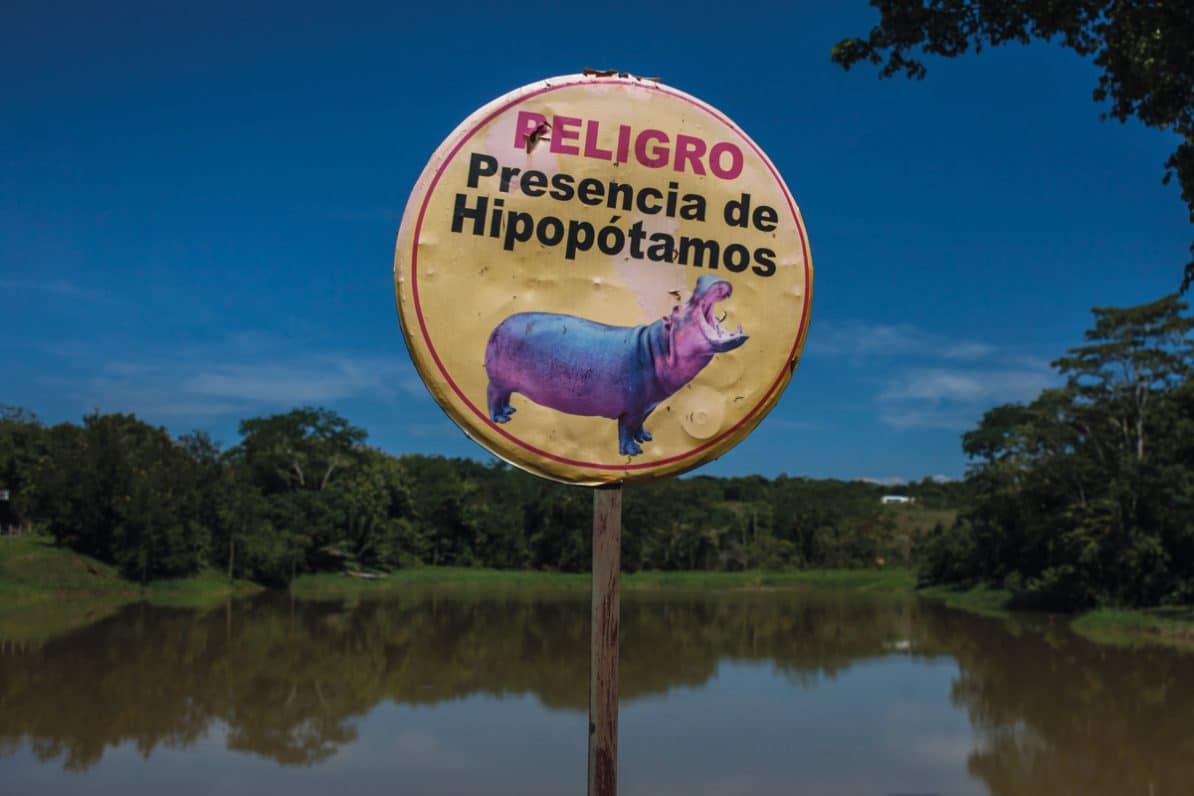
A sign warns ‘Danger, hippos present’ near the former residence of Pablo Escobar in Antioquia, Colombia. Photo: Juancho Torres / Getty Images
28th January 2020 (Taken from: #38)
“Killing a hippopotamus is quite complex,” says David Echeverri López. “Everything about hippos is very difficult, expensive and dangerous.”
You wouldn’t expect hippo extermination to be López’s problem. A biologist at Colombia’s regional environmental corporation Cornare, his primary concern is the biodiversity of the country’s northwest Antioquia region. His job description mentions nothing about bumping off troublesome semi-aquatic mammals from sub-Saharan Africa.
But hippos have set up home in Antioquia and they like it. “They have adapted easily to an ecosystem that offers them constant food throughout the year, a good climate and no real threats,” says López. “It is a very successful species at an evolutionary level; it has been on this planet for a long time. When the habitat offers better conditions than its natural one, it prospers.”
It was cocaine that first brought the hippos to this part of Colombia, 7,000 miles from their natural habitat. They were introduced by Pablo Escobar who, along with being the most famous drug dealer in history, was also something of an animal lover. The head of the Medellín cartel and once one of the world’s richest men, he spent a fortune building his own private zoo in the Hacienda Nápoles, his sprawling 2,000-hectare estate in Antioquia.
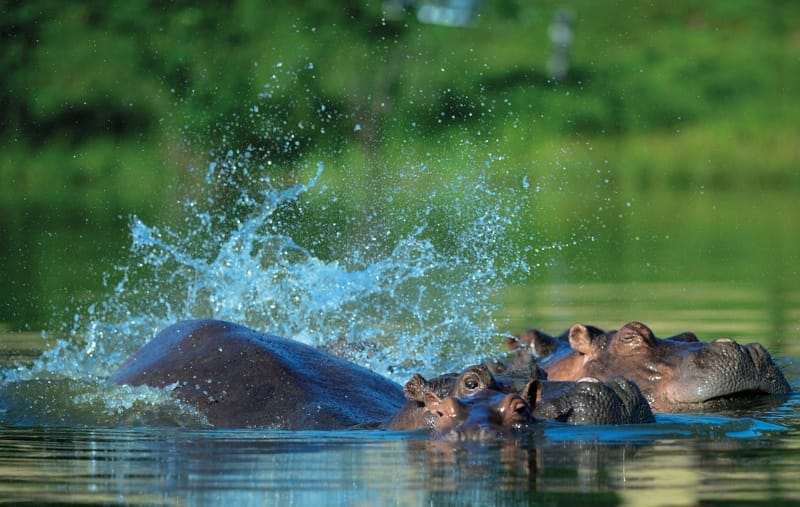
There are now an estimated 70 hippos roaming in Colombia, the biggest wild hippo herd outside of Africa. Photo: Raul Arboleda / AFP via Getty Images
Escobar threw himself into the role of zookeeper with vigour, amassing a menagerie of almost 1,200 animals. Elephants, giraffes, ostriches, zebras, antelopes, camels and pink dolphins were all smuggled into the country – although he avoided buying large predators so as to encourage the rest of his exotic eye candy to roam freely without fear of being eaten. Before each new acquisition Escobar would carefully study the National Geographic Animal Encyclopedia, picking creatures he believed would thrive in the jungles of South America. Not all of them did so – the zoo’s six giraffes starved to death after refusing to eat the food specially provided by the cartel leader – but the hippos loved their new home and Escobar was said to have had a particular soft spot for the four giant beasts that lolled in his private lake.
Unfortunately, not everyone shared his passion. After Escobar was shot dead by Drug Enforcement Administration agents and Colombian police on a Medellín rooftop in 1993 the authorities seized Hacienda Nápoles, which was later turned into a theme park. While most of the zoo’s largest residents were caught and sent off to other institutions, the hippos were left to their own devices. Some stayed on the ranch, happy to be fed by fee-paying tourists; others broke out of the estate and began roaming the Colombian jungle where they ate and bred, unencumbered by any natural predators. López estimates that 70 hippos now live in Antioquia’s lakes and rivers. “We have a problem here,” he says.

Visitors feed Vanesa, one of the hippos at the Nápoles ranch theme park in Antioquia, June 2009. Photo: Raul Arboleda / AFP via Getty Images
The old grey matter
On the surface there are few parallels to be drawn between Macclesfield and Medellín. The cobbled streets of the northern English market town are a world away from the Antioquian capital which gave its name to a cartel. Both, however, have seen a wealthy man at the top of his industry unleash an exotic invasive species upon an unsuspecting local population.
Thomas Brocklehurst was a banker and silk manufacturer who, like Escobar, had a taste for the high life and exotic animals. Brocklehurst’s own Hacienda Nápoles was Henbury Park, his 240-hectare Cheshire estate, and his equivalent of Escobar’s cocaine hippos was two grey squirrels. When Brocklehurst imported the alien pair from America in 1876 he started a trend, and soon other people began proudly shipping in and releasing their own bushy-tailed status symbols into parks and estates across the country. Much like Pablo’s hippos, the squirrels soon made themselves at home. Without the natural predators that kept squirrel numbers in check in North American forests, a grey wave rippled out across the British countryside. Initially introduced to about 30 different sites in the UK between 1876 and 1929, today there are over 2.5 million grey squirrels in the country.
“It’s often the preserve of the wealthy and the landed elite to bring in exotic species to show off,” says Dan Eatherley, author of Invasive Aliens, a history of natural interlopers into the British Isles. “The same is true of plants like the rhododendron, Himalayan balsam and giant hogweed – they started out sprucing up some estate or royal garden before breaking free and taking over. People, usually rich people, bring things in then lose interest and lose control.”
Rabbits were so pathetic when they were first brought in. They had to have their burrows dug for them”
One of Eatherley’s favourite examples is the rabbit. “Rabbits were brought to Britain as a status symbol: aristocrats loved the fur, they loved serving fresh rabbit for dinner,” says Eatherley, who notes that King Henry II liked to bestow the animals as royal gifts. Britain’s current rabbit population has its roots in the 12th century when the creatures were first brought over from the Iberian Peninsula, possibly by returning crusaders. There were few signs then that bunnies would take Britain by storm.
“Rabbits were so pathetic when they were first brought in, they had to have their burrows dug for them probably because they weren’t used to our heavy, sodden soils,” says Eatherley, who toured medieval manmade warrens while researching his book. They adapted quickly, though, breeding like the proverbial and making their way across the countryside. Rabbit numbers in the UK peaked at up to 100 million before the onset of myxomatosis in the 1950s, and today there are an estimated 30-40 million of them.
Britain didn’t learn from its bunny problem, exporting the creature across its empire. “On Christmas Day 1859 a farmer, Thomas Austin, released a dozen or more rabbits imported from the UK into Barwon Park, 115 kilometres west of Melbourne, Victoria,” notes Eatherley in Invasive Aliens. “A mere eight years later, the visiting Duke of Edinburgh was able to shoot 416 rabbits in the space of a few hours, and within a century close to a billion had colonised most of the continent, despite the best efforts of bounty-hunters and several thousand kilometres of rabbit-proof fencing. Dubbed ‘chainsaws of the Outback’, the Australian rabbits were a far cry from the frail creatures first brought to Britain in the 12th century, ravaging crops, out-eating sheep and stripping tree seedlings.”
It was 100 percent eradication or nothing. If you leave one pair of breeding rats they will return”
Rabbits were also introduced to New Zealand, with equally devastating effect. In a misguided attempt to solve the rampant bunnification of the islands, stoats and ferrets – also brought over from Britain – were released in the 1880s. The furry terminators clearly hadn’t read their job description and instead of ousting the rabbits began gorging on the eggs of New Zealand’s many ground-nesting birds. It’s thought that at least 50 native bird species have since become extinct.
“It’s very difficult to eradicate an invasive species once it has a foothold,” says Eatherley. He points to a recent £1 million government scheme backed by Prince Charles to hook grey squirrels on Nutella spiked with an oral contraceptive as one of the more unlikely rear-guard actions. “But when an invasive species is introduced because of human activity, we think it is our moral duty to rectify the problem. Often that goes wrong,” he says. “It becomes like a twisted version of the nursery rhyme. ‘There was an old woman who swallowed a fly’ – they released a rabbit to eat the shrub, they released a stoat to catch the rabbit, they released a falcon to hunt the stoat… It’s not that easy to win a war against nature’s survivors.”
Apocalypse mouse
To reach the British overseas territory of South Georgia you make your way to the Falkland Islands then take a further 800-mile boat trip to the south-east. It’s a journey few might have made had Captain Cook not seen fit to mention the large number of seals he spotted on this rocky outlier in his notes on his second voyage, published in 1777.
The promise of an island full of valuable seal pelts drew hunters to South Georgia in their droves. When they returned with tales of whale-filled waters the whalers followed suit, setting up a number of stations on the island. Every boatload of hunters brought a stowaway crew of rats and mice with them who also set up shop on the 100-mile-long, 15-mile-wide island. Fur sealing was stopped in 1912, by which time there were few seals left to kill anyway, and the last whaling station closed in 1965 having processed 172,000 carcasses. But the rodents didn’t make the return trip with the human hunters. They stayed on South Georgia and thrived.
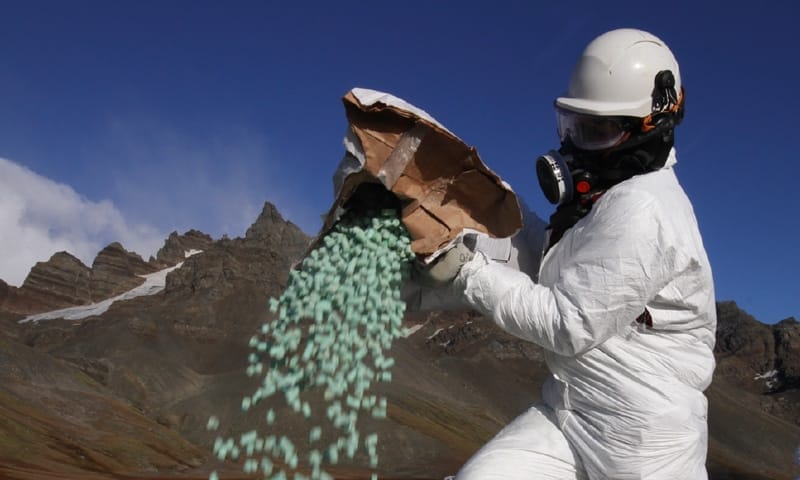
A member of Team Rat fills a baiting bucket with poisoned pellets on South Georgia, March 2015. Photo: Oli Prince
Pre rats and mice, South Georgia’s seals shared the island with millions of ground-nesting birds. Several species of albatross, alongside pintails, prions, skua, terns, sheathbills and petrels, nestled down alongside the South Georgia pipit, the world’s most southerly songbird. But the rodents cared little for warblings, no matter how southerly, and decimated the island’s bird population, feasting on the eggs and pushing the South Georgia pipit towards extinction. The birds retreated to the southern side of the island, separated from the rat- and mouse-filled north by glacial ridges. But as the world warmed, the glaciers shrank and soon the ice wall looked like becoming a thing of the past – as did the South Georgia pipit.
“It was clear we needed to take action quickly,” says Alison Neil in a soft Scottish burr that sits oddly with the pointers she gives me on rodent genocide. “But I think if we’d had any idea of what the challenge ahead was, we wouldn’t have taken it on, to be honest.” Neil is chief executive of the South Georgia Heritage Trust, a Dundee-based charity set up in 2005 by a former commander of the British forces in the Falkland Islands. Its goal is to protect South Georgia’s indigenous flora and fauna. The charity believed that the only way to safeguard the island’s birdlife was to get rid of the rodents, and the only way to get rid of the rodents was to kill them. Every last one. “It was 100 percent eradication or nothing. If you leave one pair of breeding rats they will return, which is a really daunting prospect,” says Neil. “There were lots of times when we thought, ‘Is this even possible?’”
The trust worked with eradication specialists from New Zealand and Australia to devise an ambitious plan to pelt the island with poisoned bait from helicopters over three phases, clearing one rodent-infested area penned in by glaciers before moving on to the next.
Neil, a former manager at a software company (and thus presumably used to dealing with a very different type of mouse), found herself thrown in at the deep end. “One of the first tasks was to secure two helicopters,” she says. “That was an interesting day. It turns out that it’s cheaper to buy than to rent one. We actually ended up buying a former air ambulance once owned by Aristotle Onassis.”
Having haggled for and secured their helicopters, Neil and project director Tony Martin had to work out how to get them to South Georgia – too far for the choppers to fly – and back. “For the first phase the helicopters were brought from the UK via cargo ship to the Falkland Islands and from there we actually got a lift to South Georgia from a cruise ship,” she says with justifiable pride. “For the next two phases of the project, when we had three helicopters, we chartered the RRS [Royal Research Ship] Sir Ernest Shackleton, which is the predecessor of the RRS Sir David Attenborough.”
These animals didn’t build ships to come over to rape and pillage – they were brought here”
The helicopters would take off from the boats or the island’s abandoned whaling stations to airdrop specially formulated bait. “It’s a bit like spraying crops or spreading fertiliser on a field. You’re effectively painting the land,” says Neil. “But of course, the land is not the flat field that a farmer might deal with – it’s mountainous and you need to make sure that anywhere that a rat could conceivably be there is also a pellet for that rat to eat. There was some very skilful flying required.”
The helicopters were so integral to the success of the operation that the team kept a close eye on them when they came back to the boats. “I remember a very surreal evening sat on the deck of the RRS Sir Ernest Shackleton during high winds,” says Neil. “We were all taking shifts to sit on deck, in the dark, to watch the helicopters and make sure they didn’t get buffeted about too much and come loose. I just remember looking up at the stars, feeling the rising wind, looking at this helicopter and thinking, ‘I’m not sure I’m actually going to be able to do very much if this thing does come loose and goes over the side of the ship.’ Luckily it didn’t come to that.”
In an attempt to minimise the impact on birds, the team used a poisoned bait that makes anything that eats it sensitive to light, meaning that poisoned rodents retreated underground where they succumbed to the toxin, out of reach of scavenging native birds such as skuas and giant petrels. Still, some birds did become casualties in the trust’s rodent war. “There was a small amount of incidental mortality because of the bait spreading,” says Neil sadly, “but this would be offset almost immediately by recoveries in those populations if the rats and mice weren’t predating nests. We knew that there was going to be a small amount of short-term pain, but that all populations were going to gain massively if the rodents were removed.”
It was a big if and a big gamble. In total the operation took a decade, cost over £10 million and involved the dropping of more than 300 tons of poisoned bait. After the last operation in 2015, the team faced an agonising wait to see if the rodents would return.

Rodent detection dogs Will and Ahu and their trainer Miriam Ritchie check South Georgia for rats, February 2018. Photo: Tony Martin
In 2017 and early 2018 the team visited South Georgia again to see if it had all been worth it. Using rodent detection dogs, they checked one in every 100 metres of the coastline for evidence of rats and mice. They found none. “It was a conclusive result: there weren’t any rats or mice left,” says Neil with delight. “And since that time we’ve had no conclusive sightings. I think everyone is confident that the eradication was a success.” South Georgia was officially declared rodent free later in 2018 and the birds are reclaiming the island. “What’s happening now is that the endemic birds have started to come back in large numbers,” she says. “From never hearing the song of a pipit on the main island, you now hear it wherever you go.”
At over 350,000 hectares, South Georgia is the largest place in which an invasive species has been wiped out and Neil hopes it can inspire others. “Every successful eradication of invasive species is something that the rest of the world can build on,” she says. “Maybe people feel that we can’t reverse what humanity has done, but South Georgia is evidence that you can. I think that in future, not only are you going to see this kind of eradication happen successfully on islands, but actually in countries, in continents.” New Zealanders are certainly inspired. The country has pledged to rid itself entirely of rats, Australian possums and stoats by 2050.
Nature of the beasts
Neil and the Kiwis’ vision of rolling back invasive species on a grand scale is not one shared by Erick Lundgren, an ecologist at the University of Technology in Sydney and lead author of one of two reports published this year examining the impact of Escobar’s hippos on Colombia. “The war on invasive species is very often a complete waste of time and money, a complete distraction,” he says, taking a break from packing for a field trip to study Death Valley National Park while it is closed because of Covid-19. (“I got special permission, so I’ll be out there. Dusty and alone for a very long time.”)
Lundgren concedes that South Georgia was a special case, as a delicate island habitat where a balance was unlikely to be struck between the birds and the rats. “Choosing between the birds and the rats is an ethical question,” he says. “The rats are sentient beings. They’re really fascinating, but so are these seabirds.”
Outside of such enclosed ecosystems, however, he believes conservation is overly concerned with nativism. “We define these organisms as invaders, but these animals didn’t build ships to come over to rape and pillage – they were brought here. If anything, they are escaped slaves. But if you define them as invaders, then all of a sudden anything that they do is seen as inherently bad, because that word is constraining our imagination. But if you drop that value, you find that these introduced species often play interesting ecological roles.”
Red squirrels were already in long-term decline thanks to deforestation”
Lundgren points to an example from the world of plants. “Introduced plants have often been able to deal with new conditions that native plants can’t handle, and in doing so they rejuvenate soils and end up creating conditions that allow the historically native plants to begin returning on their own,” he says. “In Puerto Rico there was massive deforestation and the soils became so brittle and nutrient-poor that the native forest just couldn’t return. They could not get these trees to grow. All these abandoned landscapes became dominated by introduced African tulip trees and other global tropical trees that had never grown there before. They created this brand new forest, restored the soil in the process and now the native trees are starting to return as a result.”
Jonathan Shurin is an ecologist with the University of California, San Diego and author of the other 2020 paper about cocaine hippos. He agrees that ‘invasive species’ is a loaded term that can be used to mask the damage humans have done to native flora and fauna. “Invasive species are often symptoms not causes,” he says. “They are able to invade not because they are inherently superior to the native species, but because the environment has been transformed in a way that benefits them. There are many cases where we ascribe a lot of negative environmental change to a species when they are really a side-effect of human activity.”
Grey squirrels in the UK offer a good example of this phenomenon, claims Eatherley. “The accepted point is that grey squirrels arrived and native red squirrels were forced out,” he says, citing the fact that the country’s red squirrel population has collapsed from over 3.5 million before the greys were introduced to just 140,000 today. “While the grey squirrels are definitely a factor, the red was already in long-term decline thanks to deforestation, particularly in Scotland.” Eatherley also points out that red squirrels were themselves regarded as pests, and that between 1903 and 1946 the Highland Squirrel Club presided over the slaughter of 102,900 reds in the north of Scotland alone, offering a bounty of four pence per tail. “We cleared the way for grey squirrels to move in.” Grey squirrels apparently make good scapegoats.
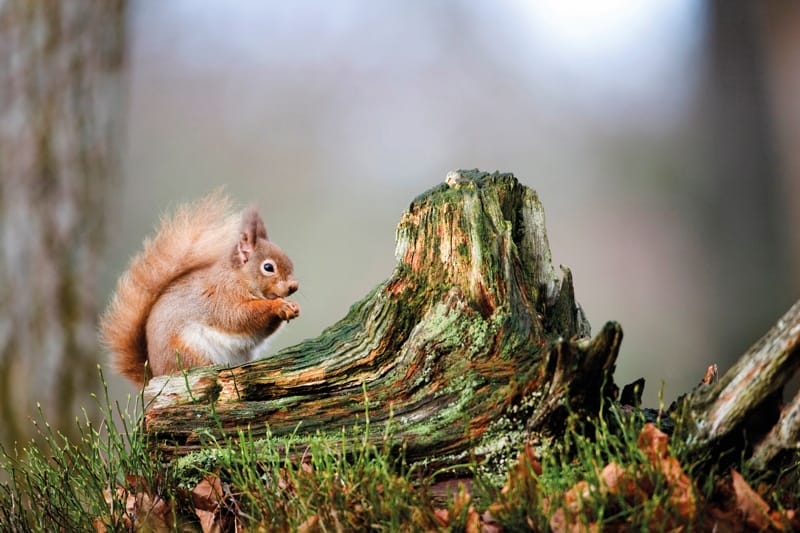
The UK’s red squirrel population has collapsed from 3.5 million to 140,000.
Photo: Loop Images / Universal Images via Getty
With so many species facing an uncertain future, Lundgren argues that it is worth exploring the idea that creatures facing extinction may thrive elsewhere as hippos, which are classified as vulnerable, have apparently done in Colombia. “The majority of the world’s large herbivores, those weighing over 100kg, are threatened or severely endangered in their native ranges,” says Lundgren. “But if you look at all populations, including introduced populations, you realise that introductions have played a real counterforce to this long-term trend of extinction and decline. Many species have found life rafts through humans into new terrains where they’re now thriving while their native populations are endangered or even extinct.”
This includes rabbits. While you’re unlikely to see Flopsy, Mopsy or Cottontail oust the panda as the WWF’s mascot anytime soon, in their native homeland on the Iberian Peninsula rabbits are struggling. A 2014 study showed that the number of rabbits in Spain had fallen by 55 percent in the last three decades to the point at which they are at risk of disappearing altogether.
That decline was mirrored by the Iberian lynx, which feeds almost exclusively on rabbits and is now the world’s most endangered cat. In a surprising reversal of history, Spanish conservationists have started re-importing rabbits from other parts of Europe in the hope of saving the lynx. They have even gone so far as to create artificial burrows as medieval lords did to help them get comfortable – at least until they become elevenses for a wildcat.
Creature features
Erick Lundgren’s study is about more than the survival of any one species. It argues that introduced animals may help restore the ecological functions of megafauna – huge herbivores such as mammoths, giant sloths and glyptodons, armadillo-type creatures the size of cars – lost to extinction during the last ice age.
“We have this idea that nature ended in 1500 AD or when the first white people got off the boat in various lands, but for 30-40 million years earth had these big animals smashing things down, pooping and ripping up the ground,” he says. “They carried out all these ecological functions that, when we see them returned today by an introduced animal, we decry as being a violation of nature. But the nature that we cherish, that we’ve enshrined as being somehow holy and fixed, is actually this really quiet, defaunated, post-extinction world. That’s actually an exception from the last 30-40 million years.”
The study estimates that since the last interglacial period 126,000 years ago, South America has lost 65 percent of its large herbivore species, but that species introduced by humans have replaced 27 percent of that biodiversity loss.
“We so often think about humans as arriving from Mars or something, but we’ve always been part of this planet, our ancestors evolving along with everything else,” says Lundgren. “We’ve been reshaping terrestrial ecosystems for 130,000 years, both reducing diversity and increasing diversity in all sorts of new ways as a consequence of our ecologies and economies.”
In our studies of ecological roles, hippos pop up closest to a giant llama”
Rather than studying how close introduced animals are to extinct native species, Lundgren and his team instead analysed whether they shared similar traits. “There’s a lot of ways to understand biodiversity, and one way is to look at species and their evolutionary distance from each other,” he says. “It’s a very important thing to look at, but it doesn’t tell you about what these organisms do and how they interact with the world. It is their physiological traits that determine how an animal or a plant affects its environment. Not what it is related to.”
By looking at traits rather than taxonomy, the team drew comparisons between the donkeys and water buffalo which have been introduced in Australia and the giant wombat and other extinct marsupials that used to roam the land. “When previous [native] animals went extinct we saw fire frequency increase drastically,” says Lundgren. “When water buffalo were introduced, wildfire frequency reduced and tree growth rates increased. They’re picking up the role previously played by other species – taking dry fibrous grass biomass and digesting it in their stomachs, as opposed to it burning in the landscape.”
Hungry, hungry hippos
So what role do hippos fill in Colombia? “The hippos are one of the more challenging of our results to talk about, because they are a really weird animal,” says Lundgren. “In our studies hippos pop up closest to a giant llama.” When met with stunned silence, he continues. “To be clear, hippos are definitely not giant llamas, but their traits suggest that they play roles similar in some ways to these llamas – in terms of their diet and digestion – but also comparable to giant, semi-aquatic rhino-like animals that previously lived there. They are resurrecting important ecologies of several extinct species, but in ways that are unique to hippos.”
While Lundgren’s time was spent analysing data from afar, Shurin’s study involved getting up close and personal with the hippos. “I’m really interested in ecosystems,” he says. “When you drop something as large as a hippo into somewhere like Colombia it is fascinating to see what happens.” Shurin and his team compared Colombian lakes containing hippos to other, hippo-free ones in the same area. The team found that even while the number of hippos is relatively small at the moment, they are having an effect.
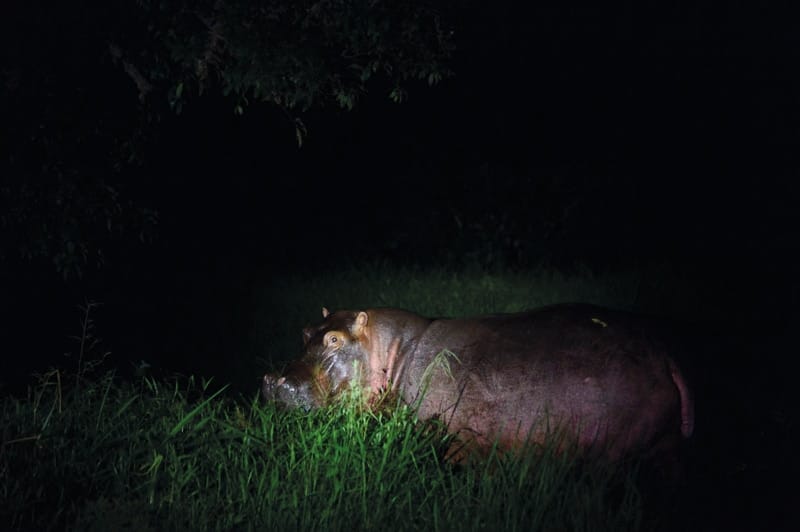
A wild hippo feeds at a farm on the outskirts of Doradal in Antioquia, June 2016. Photo: Raul Arboleda / AFP via Getty Images
“Hippos feed almost exclusively on grass,” continues Shurin. “So they feed on land at night and come into the water during the day where they excrete.” And it’s a decent-sized excretion – studies in Africa have estimated that hippos release over two kilograms of dung a day. This nutrient-heavy waste can have an impact on water quality and oxygen levels. In Africa it has been blamed for causing mass deaths of fish in certain lakes and encouraging algae to reach suffocating levels in others.
Shurin won’t be drawn on whether the hippos’ toilet habits could have an equally detrimental effect in Colombia, pointing out that the dry season in Colombia is wetter than the wet season in Tanzania and Kenya where hippos have mostly been studied. “People always want to know if these things are good or bad, and I’m reluctant to make a judgement. I just find it interesting,” he says before cracking a smile. “I guess that’s why people hate scientists!”
As hippo numbers in Colombia have increased, there have been reports of locals being hospitalised after attacks by the beasts, which can weigh over 7,000 pounds and reach speeds of 18 miles per hour. Shurin believes that if Colombia is going to go full South Georgia on the hippos, then they will need to act soon. “Letting hippos spread uncontrolled could lead to more people being attacked and issues with water quality,” he says. “If you’re going to do something, and you’re concerned with that something being humane to hippos, it’s better to do it when there’s relatively few of them. If you’re ultimately going to kill or capture them, if there are hundreds or thousands then that’s worse than if there are dozens.”
Please tell people that we have a problem here and that we lack the resources to deal with it”
For López, who deals with the animals on a regular basis, the time for action is now. “As a biologist, you know that the technical solution has always been to try to eliminate the species that exhibit this invasive behaviour,” he says. “We have sterilised more than ten hippos,” he continues, with a sigh that suggests this was not an easy task. “We have advanced a lot in the capture protocol and are looking for countries that can take them. Please tell people that we have a problem here and that we lack the resources to deal with it. If there are international entities that may consider helping us, they should know that we really need their support.”
If new homes can’t be found for Escobar’s hippos, then culling becomes a likely option. When I discuss this with Lundgren he sounds forlorn. “There are many times where organisms that we see as defiling a place and not belonging are actually part of a new network of interactions that we don’t fully understand because we don’t respect their presence there,” he says. “I think it’s dangerous. We seem to spend an awful lot of our money in conservation on killing things.”
Slow Journalism in your inbox, plus infographics, offers and more: sign up for the free DG newsletter. Sign me up
Thanks for signing up.








